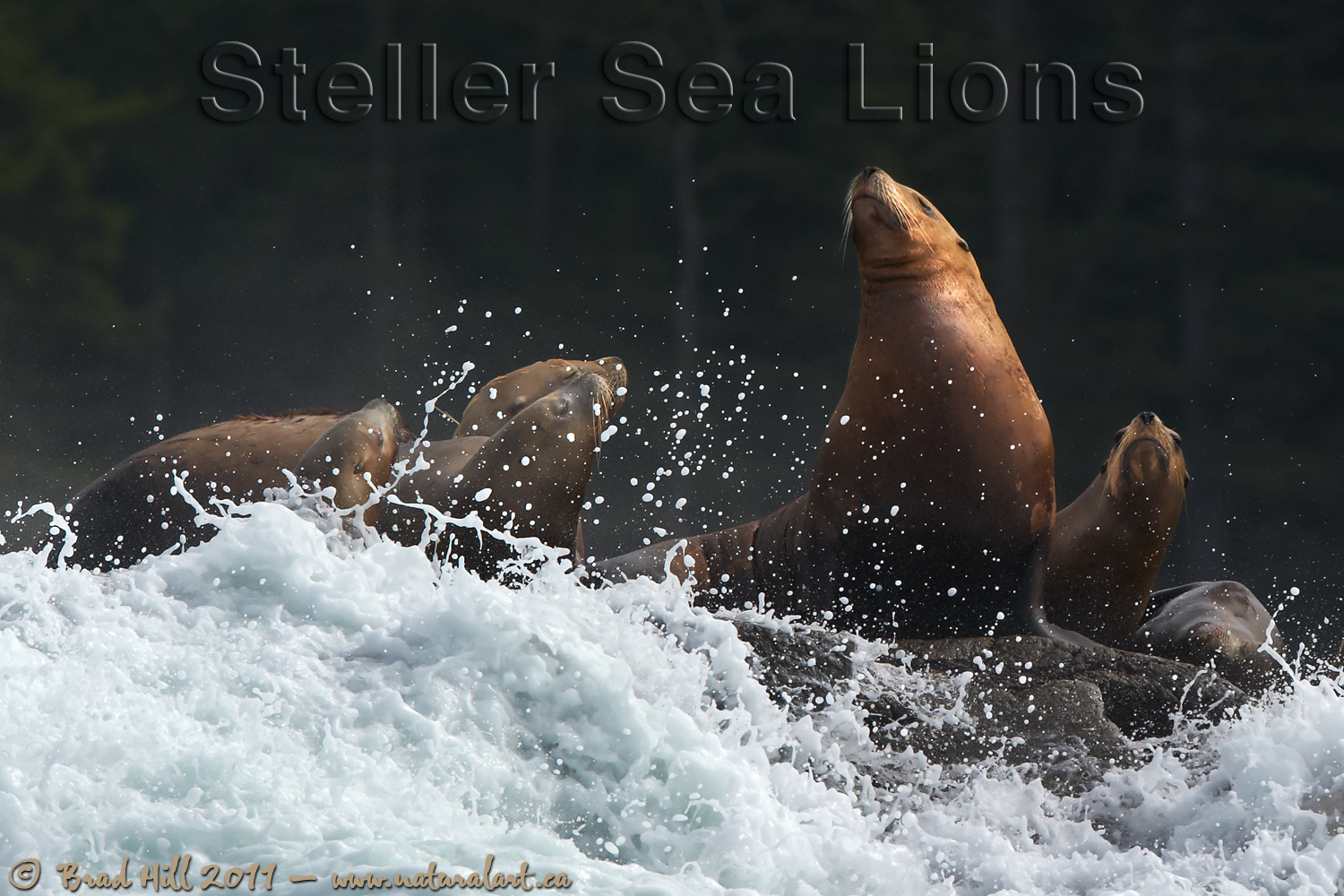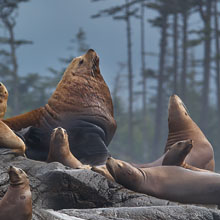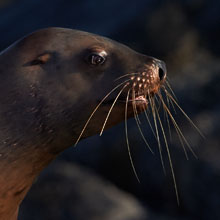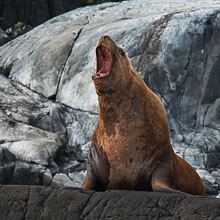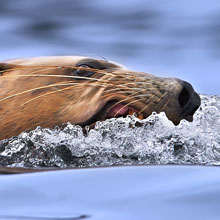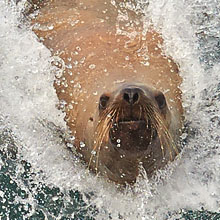Availability: Undetermined - Enquiries?
In the Field
Enduring. Northern Vancouver Island, BC, Canada. August 27, 2010.
Being a decidedly NON-aquatic mammal myself, I'm always amazed by the environmental extremes that our distant marine cousins endure on a day-to-day basis. But, I suppose, their amazing adaptations probably put them in as much comfort as I am in my cabin as I write this! But I'm not envious of having the several inch layer of blubber that provides the warmth needed to live the aquatic life...
This was a really fun shot to capture. We were pitching up-and-down and side-to-side in a small Zodiac and there was a real "Whee-hah! Ride 'em cowboy!" thrill associated with the outing. The only real "tricks" associated with the image capture were ensuring one used high enough of a shutter speed to counteract the effects of shooting from such a non-stable platform and exposing the image in a way that retained the critical highlights in the white, foamy water.
While this wasn't a shot that was technically difficult to capture, it did require a LOT of work behind the computer to make it fully come to life. Not only did it take three separate raw conversions (with merging of the output in Photoshop) to get the overall tonal range right (especially to bring out the details in the foamy water while not under-exposing the sea lions), but I had to make several adjustments to the tones in the highlight region (via tonemapping using LightZone) and, to get the sea lions illuminated correctly, I had to monkey quite a bit with the mid-tone contrast (i.e., selective exposure adjustments of the midtones using reasonably complicated luminosity masks).
I struggled with how to crop this image for web presentation where the maximum pixel dimensions are 1200 pixels on the long axis. My preferred crop for PRINT use on this image is about 95% of full frame and includes two more sea lions on the right side of the frame than the crop here does. While the two additional lions don't add a lot to the image (and some would argue they detract from it), the larger crop has a nicer diagonal feel to it and, at least to me, feels (and almost smells) saltier and "more coastal". But...when I took my preferred "print crop" and reduced it to 1200 pixels the image just didn't work for me. The main reason for this (for me) is that while the primary subject (the uppermost sea lion) still stood out nicely, what I considered the secondary subject (or supporting actor!) in the shot - the sea lion to the immediate left of the primary subject that is partially obscured by water droplets - just wasn't predominant enough in the image. So...I settled on this crop for web use - it represents about 65% of the original image. I've long thought that there is rarely "one crop that fits all uses" and that to make images look their best one has to consider the medium that is being used to display the image - what works best for a print is often NOT what works best for online use.
NOTES:
1. This image - in all resolutions - is protected by copyright. I'm fine with personal uses of it (including use as desktop backgrounds or screensavers on your own computer), but unauthorized commercial use of the image is prohibited by law. Thanks in advance for respecting my copyright!
2. Like all wildlife photographs on this website, this image was captured following the strict ethical guidelines described in The Wildlife FIRST! Principles of Photographer Conduct. I encourage all wildlife photographers to always put the welfare of their subjects above the value of their photographs.
3. This image was captured during my "Humpback, Orcas, Sea Lions & More" photo tour in August of 2010. Each year I offer trips into two different parts of the Great Bear Rainforest as well as one to photograph aquatic mammals and oceanscapes near the northern tip of Vancouver Island. And, in selected years, I also offer photo tours to locations to capture other highly sought-after subjects, such as various owl species of the boreal forest and wildlife of Canada's Arctic. Details about these trips can be found on the Photo Tours page of this website.
Behind the Camera
Enduring. Northern Vancouver Island, BC, Canada. August 27, 2010.
Digital Capture; RAW 14-bit format; ISO 250.
Nikon D3s with Nikkor 400mm f2.8 VRII lens hand-held and shot from inflatable Zodiac. VR on and set to "Normal" mode. Circular polarizer used.
1/1600s @ f7.1; -0.67 stop compensation from matrix-metered exposure setting.
At the Computer
Enduring. Northern Vancouver Island, BC, Canada. August 27, 2010.
RAW Conversion to 16-bit TIFF, including first-pass/capture sharpening using Phase One's Capture One Pro 6. Three raw conversions varying in exposure settings: one at -1.0 stops to pull back white-on-white detail in foamy water; one at -0.33 stops for rocks and background forest; one at +0.33 stops to bring out shadow detail on seal lions).
Further digital corrections on 16-bit TIFF file using Adobe's Photoshop CS5 and Light Craft's LightZone. Photoshop adjustments included compositing and masking of three source images, selective adjustment of mid-tone brightness and contrast (using luminosity masking) and selective sharpening for web output. Final tonemapping and contrast/tone tweaking performed with LightZone using the tonemapper/re-light tool.
Conservation
Enduring. Northern Vancouver Island, BC, Canada. August 27, 2010.
Ten percent of the revenue generated by this image will be donated to Raincoast*.
Species Status in Canada**: Special Concern (November 2003) - protected in Canada since 1970.
The Steller's Sea-Lion (Eumetopias jubatus) is the largest of the sea-lions, and males can weigh up to a ton (females are considerably smaller and rarely weigh over 600 lb). Males compete among themselves for females, and successful males end up breeding with several females within their harem.
From the early 1900's through to the 1970's huge numbers of Steller's Sea-Lions were culled for their fur and to remove a competitor (for humans) for salmon. During that time approximately 55,000 sea lions were killed and the breeding population of BC was lowered to about 4,000 animals. Since the Steller Sea Lion first received protection in 1970 the population in the coastal waters of BC has grown to between 18,000 to 19,700 animals (7,600 or so of these are of breeding age).
*The Raincoast Conservation Society (and Foundation) is an effective and efficient organization that has been fighting for protection of this unique habitat. If you are looking for a meaningful way to contribute to the conservation of this amazing ecosystem, Raincoast will provide maximal "bang" for your conservation dollars.
**as determined by COSEWIC: The Committee on the Status of Endangered Wildlife in Canada












